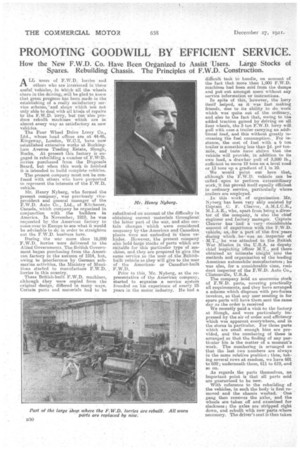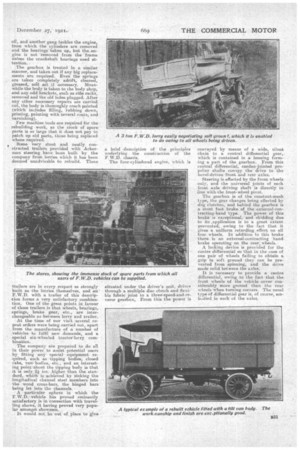PROMOTING GOODWILL BY EFFICIENT SERVICE.
Page 12

Page 13

If you've noticed an error in this article please click here to report it so we can fix it.
ALL users of F.W.D. lorries and others who are inter-ested in the.se useful vehicles, in 'Which all the wheels share in the driving, will be glad to know that great progress has been, made in the establishing of a really satisfactory Her-. vico scherite,'and shopa which are hot only able to deal with all kinds of repairs to the F.W.D. lorry, 'butCan"alSo produce rebuilt machines which are in almost every way as satisfactory as new
vehicles. , • ' The Four Wheel Drive Lorry Co., Ltd., whose head offices are at 44-46, Kingswav, London, W.0.2, have now established extensive works, at Buckingham Avenue Trading Estate, Slough, Bucks. At present this factory is engaged in rebuilding a number -of F.VtirtD. lorries purchased from the Disposals Board, but when this work is finished it is intended. to build complete yehicles.
The present company must not be confused with others who have purported to represent the interests of the F.W.D. vehicle.
Mr. Renry Nyberg, who formed the . present company, was previously vicepresident and general mana.ger of the F.W.D. Auto Co., Ltd., of Kitchener, Canada, which company he organized in conjunction with the builders in America. In November, 1919, he was requested by the American factory to come over to Europe to see what it would be advisable to do in order to straighten out the F.W.D. business here.
During the war more than 16,000 F.W.D. lorries were delivered to the Allied Governments. The British Government began purchasing from the American factory in the autumn of 1914, but, owing to interference by German submarine activities, the Ministry of Munitions started to manufacture F.W.D. lorries in this country.
These British-built F.W.D. machines, although they were copied from the original design, differed in many ways. Certain parts and materials had to be substituted oil: account of the difficulty in obtaining correct -Materials throughout the latter part of the war, and also eel-tabs ohangeS which were considered necessary by the-American and Canadian plants. Were not embodied in these ye;
However, the 'present company else hold 'large StoCks of parts which are sidtable for this particular type of "machine; nod, they are prepared to' give the same service to the user of', the Britiabbuilt yebicle as they will give to the user of • the Americanor Canadian-built
Prior to this, Mr. Nyberg, as the representative of the American' company, started to erganize a service system founded on his experience of nearly 25 years in the motor industry. lie had a difficult task to handle, on account of the fact that. more than 1,000 F.W.D. machines had been sold from the dumps and put out amongst users without any service information or instructions.
In Spite of this, however, the lorry itself helped, as it was fast making friends, due to its ability to do work which was' quite out of the ordinary, and also to the fact that, owing to the added traction gained by driving on all four wheels, the 3 ton F:W.D. lorry will pull with ease a trailer carrying an additional load, and this without greatly increasing the fuel consumption., For instance, the cost of fuel with a 6 ton trailer is something less than d. per tonmile, and tests have shiEiwn that the vehicle will provide, in addition to its own load, a drawbar pull of 3,800 lb. sufficient to move 19 tons on a level road or 13 tons up a gradient of 1 in 10. . We would point out here that, although the 'F.W.D. vehicle can be calledupon to' perform extraordinary work, it has proved itself equally effieient in ordinary serviee; particularly 'where. .trailers are employed.
. In: this. work . of organization, Mr. Nyberg has been very ably assisted by Captain C. F. Cleaver, A.M.I.C.E., 1.1.1.A.E., Who, apart from being's direotor, of the company, is" Also the ehief engineer and factnry manager. 'Captain Cleaver has"' had' a very considerable amount Of experience with the F.W.D. vehicle,AS, .for; a part 'of -the. fiva years duringwhich, he, was an inspector of MT., • he was attached to the British War Mission in the U.S.A. as deputy chief inspecting OffiCei M.T., and there obtained an intimate inSight..int.6 the methods and organization of the leading American automobile-miturfactuters; he was also, for a considerable time, resident inspector of the F.W.D. Auto Co., Clintonville,
The company hold an enormous stock of F.W.D. parts, covering practically all requirements, and they have arranged a scheme which disposes with pro-forma invoices, so that any user sending in for spare parts will have them, sent the same day as the order is received We recently paid a visit to the factory at Slough, and were particularly ins, pressed by the air of order and efficiency which was apparent everywhere, and in the stores in particular. For those parts which are small enough bins are provided, and the numbering of these is arranged so that the finding of any particular bin is the matter of a monient's work. The numbering is arranged so that the last two numbers are always in the same relative position; thus, taking several rows at random, we have 601 to 609; underneath these, 611 to 618, and SO OR.
As regards the parts themselves, an important point is that all parts sold are guaranteed to be new. With reference to the rebuilding of the vehicles; in each the body is first removed • and the chassis washed. One gang then removes the axles, and the wheels are taken off and examined for slackness ; the axles are stripped right down, and rebuilt with new parts where necessary. The driver's seat is then taken off, and another gang tackles the engine, from which the cylinders are removed and the bearings taken up, but the_engine is not removed from the frame unless the crankshaft bearings need attention.
The gearbox is treated in a similar manner, and taken out if any big replacements are required. Even the springs are taken completely adrift, cleaned, greased, and set if necessary. Meanwhile the body is taken to the body shop, and any odd brackets, such as rifle racks, removed and the old holes plugged. After any other necessary repairs are carried Out, the body is thoroughly coach painted (which includes filling, rubbing down, priming, painting with several costs, and varnishing).
Few machine tools are required for the rebuilding work, as the stock of spare parts is so large that it does not pay to patch up old parts, these being replaced where required.
Some very stout and neatly constructed. trailers provided with _Ackerman steering have been built by the company from lorries which it has been deemed unadvisalle to rebuild. These trailers are in every respect as strongly built as the lorries themselves, and an • F.W.D. with a trailer of this description forms a very satisfactory combination. One of the great points in favour of these trailers is that wheels, bearings, springs, brake gear, etc., are interchangeable as -between lorry and trailer.
At the time of our visit several repeat orders were being carried out, apart from the manufacture of a number of vehicles to fulfil new demands', and a special six-wheeled tractor-lorry combination.
The company are prepared to do all in their power to assist potential users by fitting clay specialequipment required, such as tipping bodies, closed cabs, vatt-bodies, etc., and an interesting point.about the tipping body is that
i it s only 2i ins._ higher than the standard, whirls is achieved by Sinking the longitudinal channel steel members into the wood cross-bars, the hinged bars being let into the channels.
A particular sphere in which the FWD -vehicle has proved eminently satisfactory is in connection -with travelling shows it having proved very popular amongst showmen.
It would not be out of. place to give a brief .-description of the principles underlying. the construction of the F.W.D. chassis.
The four-cylindered engine, which is situated under the driver's seat, drives through a multiple disc clutch and flexible fabric joint to a three-speed-and-reverse gearbox, From this the power is
conveyed by means of a wide, silent chain to a central differential gear, which is contained in a housing forming a part of the gearbox. From this central differential, cardan-jointed propeller shafts convey the drive to the beveledriileu front and rear axles.
Steering is effected by the front wheels. only, ana the universal joints of each front axle drivingshaft is directly in line with the front-wheel pivot.
The gearbox is of the constant-mesh type, the gear changes being effected by dog clutches, and behind the gearbox is a stout foot brake of the external-contracting-band type. The power of this brake is exceptional, and skidding duo to its _application is to a great extent prevented, owing to the fact that it gives a uniform retarding effort on all four wheels. In addition to this brake there is an external-contracting hand brake operating on the rear wheels.
A locking device is provided for the centre differential so that in the case of one pair of wheels failing to obtain a grip in soft ground they can be pievented from spinning, and the drive made solid between the axles.
It is necessary to provide a centre differential, owing to the fact that the front wheels of the vehicle cover considerably more ground than the rear wheels when turning corners. The usual type of differential gear is, of course, emhedied in each of the axles.
































